Changes in the Occurrence of Uncommon Species of Small Terrestrial Mammals (Eulipotyphla, Rodentia) in the Czech Republic
Abstract
1. Introduction
1.1. Small Terrestrial Mammals
1.2. Uncommon Species of Small Terrestrial Mammals
1.3. Mammals in the Czech Republic
1.4. Mammal Monitoring in the Czech Republic
| Species | Order | IUCN Status ** | Council Directive 92/43/EEC Status *** | Decree No. 395/1992 Coll. Status *** | Red List of Mammals of the Czech Republic ** | Main Reason for Inclusion |
|---|---|---|---|---|---|---|
| Apodemus agrarius | Rodentia | LC | - | - | LC | Occurrence only in part of the Czech Republic |
| Apodemus uralensis | Rodentia | LC | - | - | LC | Occurrence only in part of the Czech Republic |
| Arvicola amphibius | Rodentia | LC | - | - | LC | Data deficient |
| Cricetus cricetus * | Rodentia | CR | HD IV | 2 | LC | Occurrence only in part of the Czech Republic |
| Crocidura leucodon | Eulipotyphla | LC | - | 3 | LC | Occurrence only in part of the Czech Republic |
| Crocidura russula * | Eulipotyphla | LC | - | - | - | A new species for the Czech Republic; data deficient |
| Crocidura suaveolens | Eulipotyphla | LC | - | - | LC | Data deficient |
| Dryomys nitedula * | Rodentia | LC | HD IV | 2 | LC | Occurrence only in part of the Czech Republic |
| Eliomys quercinus * | Rodentia | VU | - | 1 | CR | Protected on multiple levels |
| Glis glis | Rodentia | LC | - | 3 | DD | Data deficient; protected on national level |
| Micromys minutus | Rodentia | LC | - | - | LC | Data deficient |
| Microtus subterraneus | Rodentia | LC | - | - | LC | Data deficient |
| Muscardinus avellanarius | Rodentia | LC | HD IV | 2 | LC | Protected on multiple levels |
| Neomys milleri | Eulipotyphla | LC | - | - | LC | Data deficient |
| Neomys fodiens | Eulipotyphla | LC | - | - | LC | Data deficient |
| Sicista betulina | Rodentia | LC | HD IV | 2 | VU | Protected on multiple levels |
| Sorex alpinus | Eulipotyphla | NT | - | 2 | VU | Protected on multiple levels |
| Spermophilus citellus * | Rodentia | EN | HD II + HD IV | 1 | CR | Protected on multiple levels |
1.4.1. BioLib.cz
1.4.2. NDOP
1.5. Aim of the Paper
2. Materials and Methods
- Setting criteria: identifying uncommon small terrestrial mammal species based on these criteria.
- Creation of a database of reliable unpublished records from the territory of the Czech Republic.
- Comparison of the created database with published reliable data.
- Interpretation of findings for individual species.
- The first record of a species in a given quadrat.
- A record from an elevation outside the typical elevation range of the species in the Czech Republic (Table 2).
3. Results
| Species | Preferred Habitats | Typical Elevation Range in CZ [19,20] | KFME Quadrats with Records in CZ [25] | Records in CZ [25] | Areal Trends in Central Europe |
|---|---|---|---|---|---|
| Apodemus agrarius | Agricultural landscape, shrubby ecotones [28] | ~200–600 m | 201 | 1167 | Expansion north and west [29,30] |
| Apodemus uralensis | Lowland arable landscape [31] | ~150–400 m | 43 | 143 | Disjunct but stable [31,32] |
| Arvicola amphibius | Freshwater riparian zones [33] | ~200–800 m | 482 | 1610 | Stable [33,34] |
| Crocidura leucodon | Arable and pastureland [35] | ~150–600 m | 229 | 452 | Expansion north [20,36] |
| Crocidura suaveolens | Synanthropic agricultural landscape [37] | ~200–600 m | 487 | 1502 | Expansion north [18,38] |
| Glis glis | Old-growth deciduous forests [39] | ~200–600 m | 249 | 3789 | Stable [40] |
| Micromys minutus | Monocotyledonous vegetation [41] | ~200–600 m | 480 | 1305 | Stable [42] |
| Microtus subterraneus | Natural and seminatural grasslands [43] | ~200–800 m | 134 | 307 | Stable [44] |
| Muscardinus avellanarius | Forests and shrublands [45,46] | ~140–750 m | 432 | 3804 | Stable [47] |
| Neomys fodiens | Freshwater riparian zones [48] | ~200–600 m | 601 | 2256 | Stable [20,49] |
| Neomys milleri | Freshwater riparian zones [49] | ~200–700 m | 458 | 1240 | Stable [49] |
| Sicista betulina | Mountain forests [50] | ~600–1000 m | 46 | 188 | Data deficient, fragmented [51] |
| Sorex alpinus | Mountain forests and grasslands [52] | ~500–1200 m | 135 | 626 | Data deficient, fragmented [20,53] |
| Species | First Records | Rediscoveries After >10 Years) | Exceptional Elevations | ||||
|---|---|---|---|---|---|---|---|
| Number of Quadrats | Quadrat Number | Number of Quadrats | Quadrat Number | Found Range (m) | Outside Typical Elevation Range in CZ | Record Elevations | |
| Apodemus agrarius | 1 | 6665 | 0 | – | 235–999 | 18 above | 2× over 900 m; 2× over 700 m |
| Apodemus uralensis | 1 | 6171 | 1 | 7065 | 184–470 | 1 above | over 400 m |
| Arvicola amphibius | 2 | 5157; 5663 | 5 | 5852,5860, 5861, 5962, 5966 | 233–805 | 1 above | over 800 m |
| Crocidura leucodon | 4 | 5347; 5744; 5764; 6766 | 1 | 6767 | 162–799 | 7 above | 7× over 700 m |
| Crocidura suaveolens | 1 | 5663 | 2 | 5860; 5962 | 190–947 | 7 above, 3 below | 1× over 900 m; 3× over 700 m; 3× below 200 m |
| Glis glis | 0 | - | 2 | 5057; 5361 | 463–1177 | 493 above | 1× over 1000 m; 74× over 900 m; 219× over 800 m |
| Micromys minutus | 4 | 5445; 5764; 5770; 6475 | 5 | 5662; 5844; 5860; 5966; 6766 | 162–870 | 18 above, 7 below | 4× over 800 m; 9× over 700 m; 7× below 200 m |
| Microtus subterraneus | 7 | 5770; 5845; 6475; 6766; 6851; 6962; 7065 | 2 | 5860; 6665 | 172–1200 | 29 above, 18 below | 16× over 1100 m; 3× over 1000 m |
| Muscardinus avellanarius | 3 | 5361; 5761; 5769 | 5 | 5260; 5359; 5360; 6171; 6472 | 237–1238 | 2253 above | 2× over 1200 m; 16× over 1100 m; 54× over 1000 m |
| Neomys fodiens | 0 | - | 7 | 5157; 5860; 5862; 5962; 6064; 6362; 6766 | 162–1238 | 41 above, 1 below | 3× over 1200 m; 6× over 1000 m; 1× below 200 m |
| Neomys milleri | 0 | - | 3 | 5962; 6475; 6962 | 302–940 | 15 above | 3× over 900 m; 4× over 800 m |
| Sicista betulina | 0 | - | 1 | 5768 | 605–1200 | 4 above | 2× over 1100 m; 2× over 1000 m |
| Sorex alpinus | 0 | - | 1 | 5663 | 516–1238 | 7 above | 7× over 1200 m |



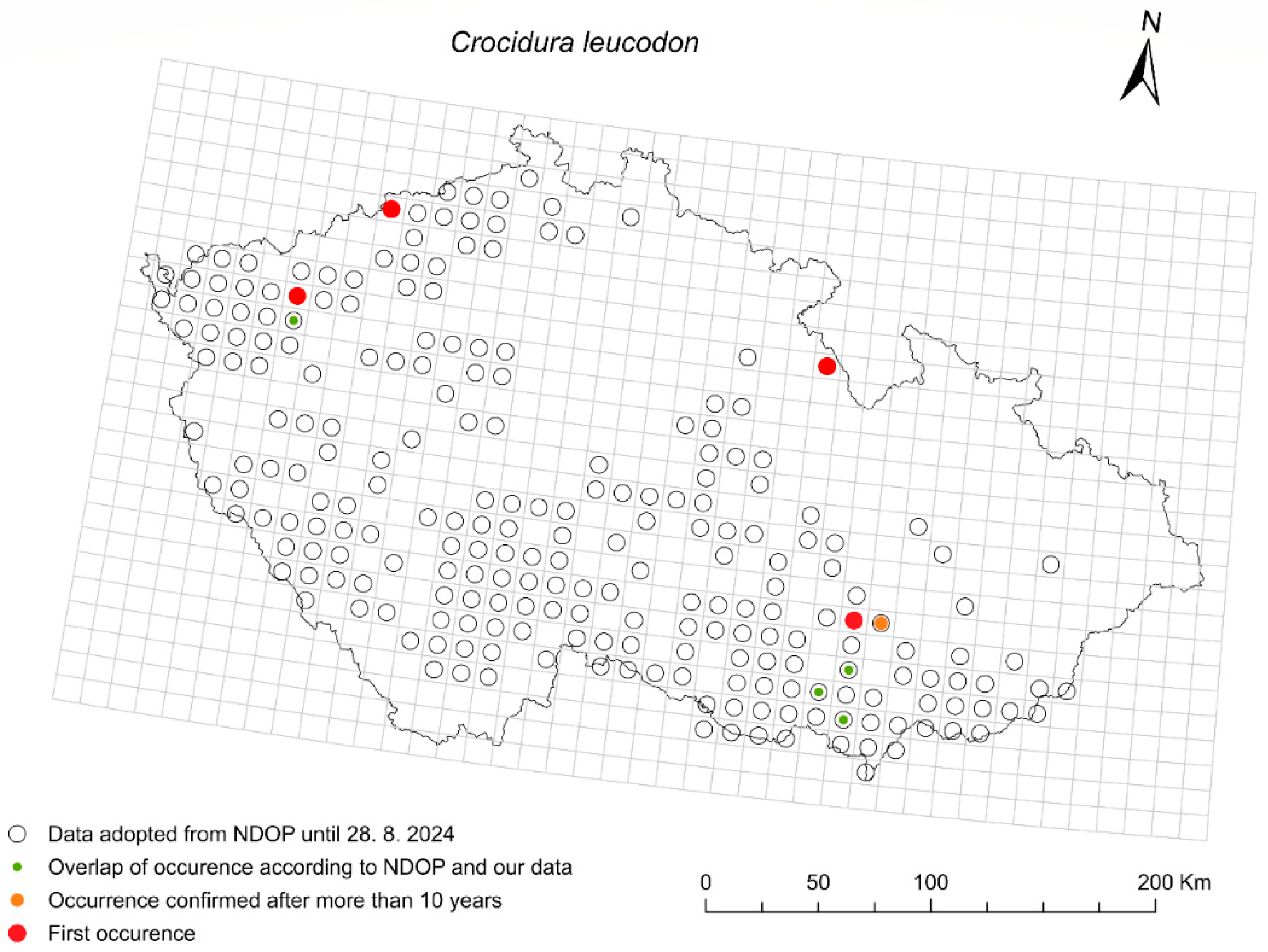





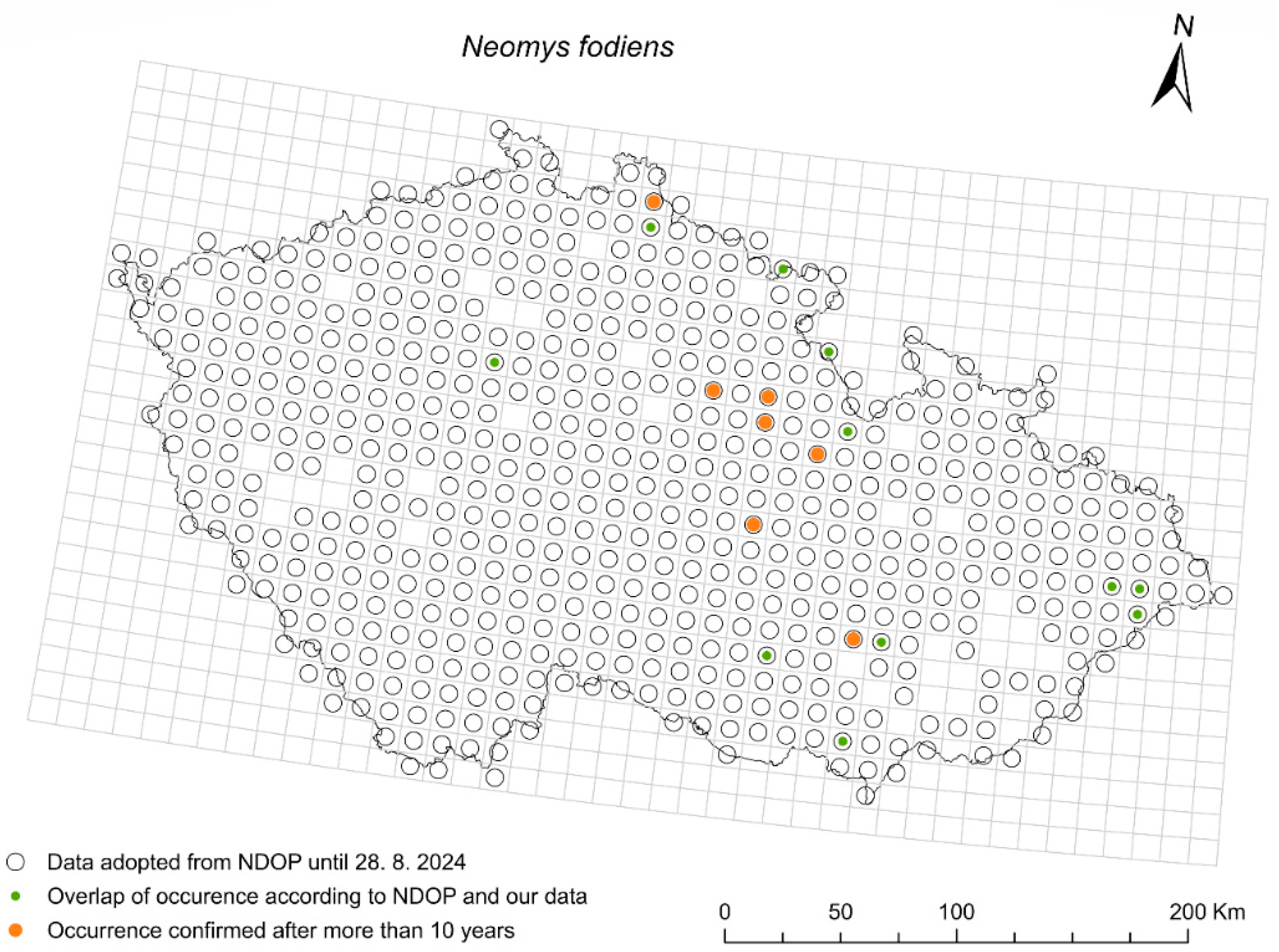
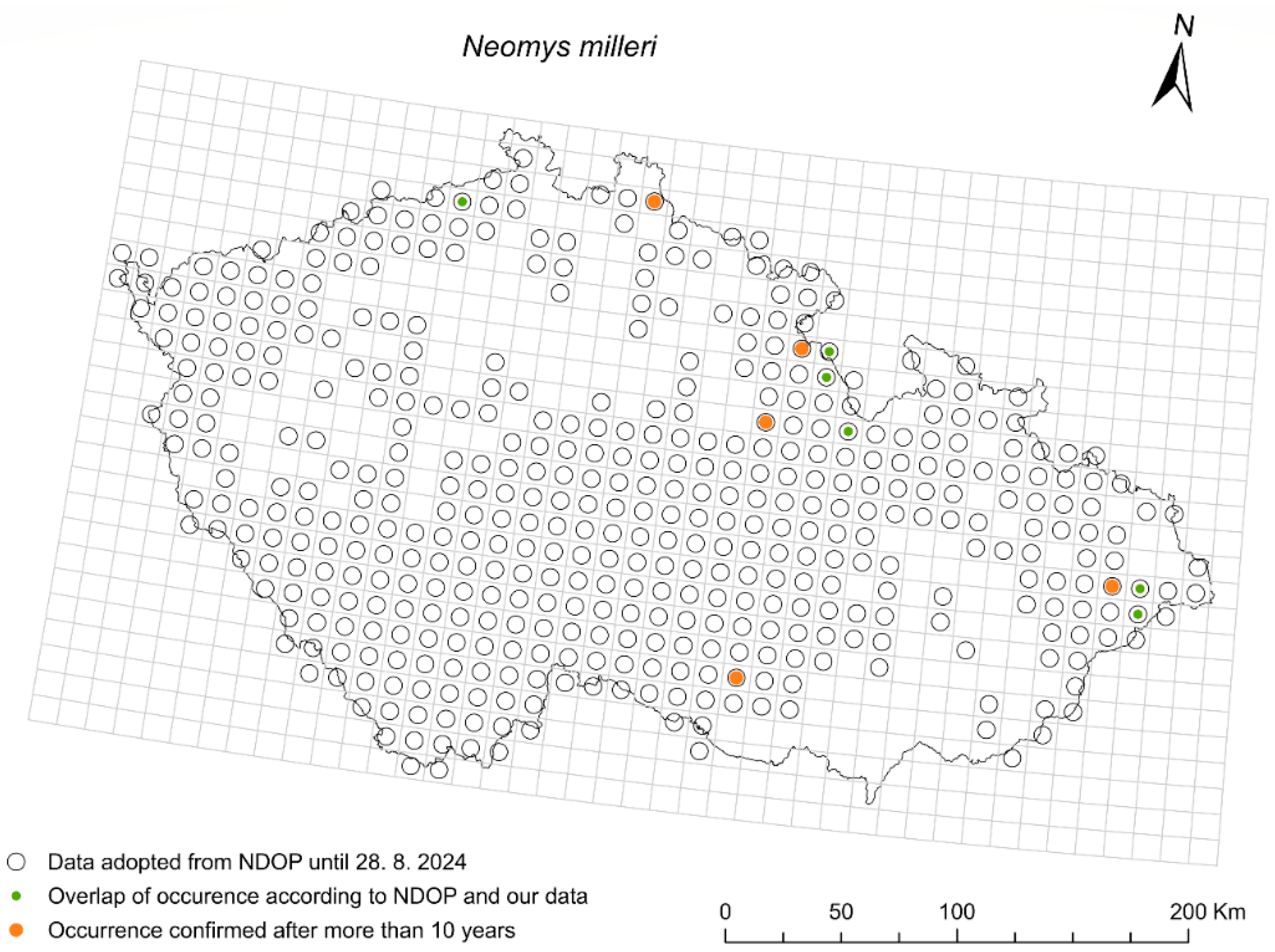
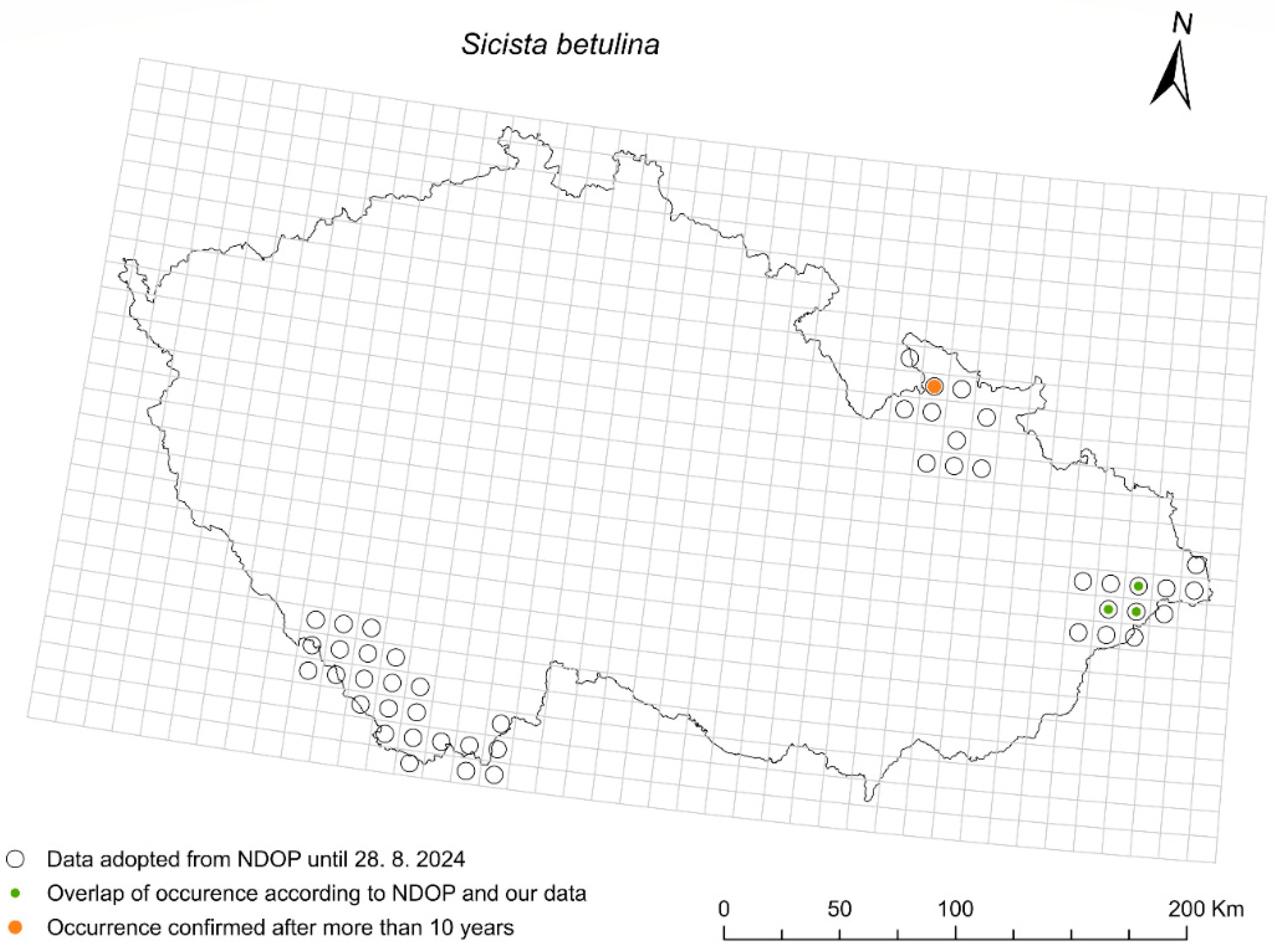
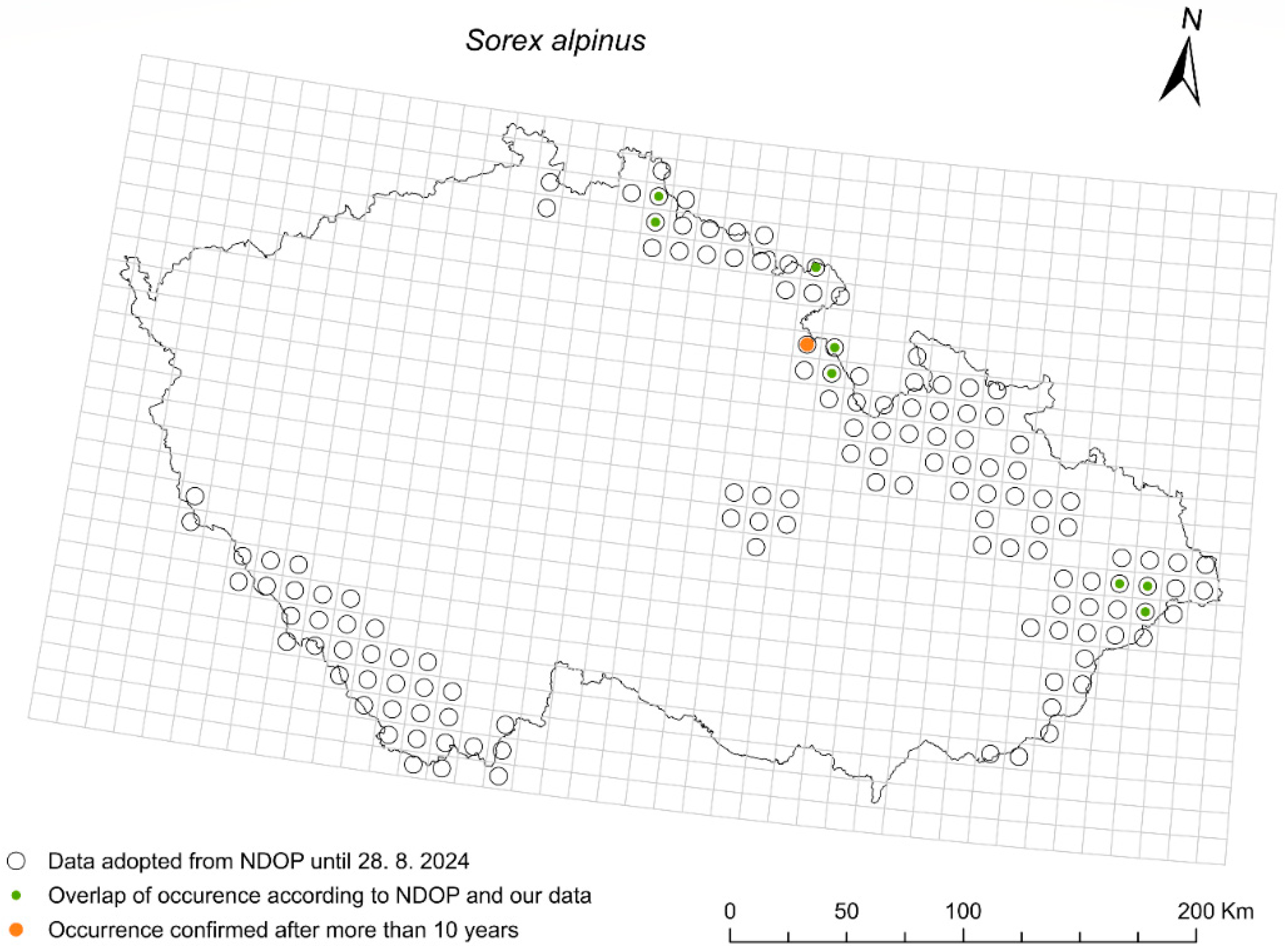
4. Discussion
- (1)
- Widespread but under-recorded species
- (2)
- Rare mountain relict species
- (3)
- Expanding species
5. Conclusions
Supplementary Materials
Author Contributions
Funding
Institutional Review Board Statement
Data Availability Statement
Acknowledgments
Conflicts of Interest
Abbreviations
| KFME | Kartierung der Flora Mitteleuropas; is a network mapping system for geographical mapping of plants and animals in Central Europe, which divides the territory into mapping fields measuring 10’ longitude and 6’ latitude. |
| NDOP | Species Occurrence Database by the Nature Conservation Agency of the Czech Republic |
References
- Lacher, T.E.; Davidson, A.D.; Fleming, T.H.; Gómez-Ruiz, E.P.; McCracken, G.F.; Owen-Smith, N.; Peres, C.A.; Vander Wall, S.B. The Functional Roles of Mammals in Ecosystems. J. Mammal. 2019, 100, 942–964. [Google Scholar] [CrossRef]
- Beca, G.; Valentine, L.E.; Galetti, M.; Hobbs, R.J. Ecosystem Roles and Conservation Status of Bioturbator Mammals. Mamm. Rev. 2022, 52, 192–207. [Google Scholar] [CrossRef]
- Godó, L.; Valkó, O.; Borza, S.; Deák, B. A Global Review on the Role of Small Rodents and Lagomorphs (Clade Glires) in Seed Dispersal and Plant Establishment. Glob. Ecol. Conserv. 2022, 33, 17. [Google Scholar] [CrossRef]
- Kollberg, I.; Bylund, H.; Huitu, O.; Björkman, C. Regulation of Forest Defoliating Insects through Small Mammal Predation: Reconsidering the Mechanisms. Oecologia 2014, 176, 975–983. [Google Scholar] [CrossRef]
- Pineda-Munoz, S.; Alroy, J. Dietary Characterization of Terrestrial Mammals. Proc. R. Soc. B Biol. Sci. 2014, 281, 20141173. [Google Scholar] [CrossRef]
- Stoddart, D.M. Ecology of Small Mammals; Springer Science & Business Media: Berlin/Heidelberg, Germany, 2012; ISBN 978-94-009-5772-5. [Google Scholar]
- Cornulier, T.; Yoccoz, N.G.; Bretagnolle, V.; Brommer, J.E.; Butet, A.; Ecke, F.; Elston, D.A.; Framstad, E.; Henttonen, H.; Hornfeldt, B.; et al. Europe-Wide Dampening of Population Cycles in Keystone Herbivores. Science 2013, 340, 63–66. [Google Scholar] [CrossRef]
- McCleery, R.; Monadjem, A.; Conner, L.M.; Austin, J.D.; Taylor, P.J. Methods for Ecological Research on Terrestrial Small Mammals; JHU Press: Baltimore, MD, USA, 2022; ISBN 1421442124. [Google Scholar]
- Hurst, Z.M.; McCleery, R.A.; Collier, B.A.; Silvy, N.J.; Taylor, P.J.; Monadjem, A. Linking Changes in Small Mammal Communities to Ecosystem Functions in an Agricultural Landscape. Mamm. Biol. 2014, 79, 17–23. [Google Scholar] [CrossRef]
- Merritt, J.F. The Biology of Small Mammals; The Johns Hopkins University Press: Baltimore, MD, USA, 2010; ISBN 978-0-8018-7950-0. [Google Scholar]
- Borgmann-Winter, B.W.; Stephens, R.B.; Anthony, M.A.; Frey, S.D.; D’Amato, A.W.; Rowe, R.J. Wind and Small Mammals Are Complementary Fungal Dispersers. Ecology 2023, 104, e4039. [Google Scholar] [CrossRef]
- Jacob, J.; Tkadlec, E. Rodent Outbreaks in Europe: Dynamics and Damage. In Rodent Outbreaks—Ecology and Impacts; Belmain, G.R., Brown, S.R., Hardy, P.R., Eds.; Singleton: Bolton, UK, 2010; pp. 207–223. [Google Scholar]
- Jánová, E. Emerging and Threatening Vector-Borne Zoonoses in the World and in Europe: A Brief Update. Pathog. Glob. Health 2019, 113, 49–57. [Google Scholar] [CrossRef]
- Davies, T.J.; Fritz, S.A.; Grenyer, R.; Orme, C.D.L.; Bielby, J.; Bininda-Emonds, O.R.P.; Cardillo, M.; Jones, K.E.; Gittleman, J.L.; Mace, G.M.; et al. Phylogenetic Trees and the Future of Mammalian Biodiversity. Proc. Natl. Acad. Sci. USA 2008, 105, 11556–11563. [Google Scholar] [CrossRef]
- Rowe, R.J.; Terry, R.C. Small Mammal Responses to Environmental Change: Integrating Past and Present Dynamics. J. Mammal. 2014, 95, 1157–1174. [Google Scholar] [CrossRef]
- Krojerová-Prokešová, J.; Barančeková, M.; Šímová, P.; Šálek, M.E.; Anděra, M.; Bejček, V.; Hanák, V.; Hanel, L.; Lusk, S.; Mikátová, B.; et al. Species Richness of Vertebrates in the Czech Republic. Folia Zool. 2008, 57, 452–464. [Google Scholar]
- Anděra, M.; Gaisler, J. Savci České Republiky: Popis, Rozšíření, Ekologie, Ochrana [Mammals of the Czech Republic: Description, Distribution, Ecology, Protection]; Academia: Praha, Czech Republic, 2012. [Google Scholar]
- De Bellocq, J.G.; Fornůsková, A.; Ďureje, L.; Bartáková, V.; Daniszová, K.; Dianat, M.; Janča, M.; Šabata, P.; Šeneklová, N.; Stodůlka, T.; et al. First Record of the Greater White-Toothed Shrew, Crocidura russula, in the Czech Republic. J. Vertebr. Biol. 2023, 72, 23047.1–23047.9. [Google Scholar] [CrossRef]
- Anděra, M. Current Distributional Status of Rodents in the Czech Republic (Rodentia) Aktuální Stav Poznání Výskytu Hlodavců v České Republice (Rodentia). Lynx 2011, 42, 5–82. [Google Scholar]
- Anděra, M.; Hanzal, V. Atlas Rozšíření Hmyzožravců České Republiky [Atlas of Distribution of Insectivores of the Czech Republic]; Agentura Ochrany Přírody a Krajiny ČR: Prague, Czech Republic, 2022. (In Czech) [Google Scholar]
- Anděra, M.; Horáček, I. Poznáváme Naše Savce. 2. Přepracované Vydání; Sobotales: Jihlava, Czech Republic, 2005. [Google Scholar]
- Ehrendorfer, F.; Hamann, U. Vorschläge Zu Einer Floristischen Kartierung von Mitteleuropa. Berichte Dtsch. Bot. Ges. 1965, 78, 35–50. [Google Scholar]
- ESRI ‘ArcGIS Pro’. Redlands: CA: Environmental Systems Research Institute. Available online: https://www.esri.com/en-us/arcgis/products/arcgis-pro/overview (accessed on 30 August 2024).
- Arcdata Prague Digitální Vektorová Geografická Databáze České Republiky, Verze 3.3. Available online: https://www.arcdata.cz/cs-cz/produkty/data/arccr?utm (accessed on 30 August 2024).
- NCA CR NDOP (Species Occurrence Database) by AOPK ČR (Nature Conservation Agency of the Czech Republic). Available online: https://portal23.nature.cz/nd/find.php (accessed on 30 August 2024).
- Batzli, G.O. Dynamics of Small Mammal Populations: A Review. In Wildlife 2001: Populations; McCullough, D.R., Barrett, R.H., Eds.; Springer: Berlin/Heidelberg, Germany, 1992; pp. 831–850. [Google Scholar]
- Tkadlec, E.; Zejda, J. Density-Dependent Life Histories in Female Bank Voles from Fluctuating Populations. J. Anim. Ecol. 1998, 67, 863–873. [Google Scholar] [CrossRef]
- Kaneko, Y.; Kryštufek, B.; Zagarondnyuk, I.; Vohralík, V.; Batsaikhan, N.; Avirmed, D.; Sukhchuluun, G. Apodemus agrarius. In IUCN Red List of Threatened Species; IUCN: Gland, Switzerland, 2016. [Google Scholar]
- Petrosyan, V.; Dinets, V.; Osipov, F.; Dergunova, N.; Khlyap, L. Range Dynamics of Striped Field Mouse (Apodemus agrarius) in Northern Eurasia under Global Climate Change Based on Ensemble Species Distribution Models. Biology 2023, 12, 1034. [Google Scholar] [CrossRef]
- Balčiauskas, L.; Balčiauskienė, L. Striped Field Mouse Invading Human-Modified Environments of Lithuania during Last Five Decades. Land 2024, 13, 1555. [Google Scholar] [CrossRef]
- Kryštufek, B.; Sozen, M.; Bukhnikashvili, A. Apodemus uralensis. In IUCN Red List of Threatened Species; IUCN: Gland, Switzerland, 2016. [Google Scholar]
- Cichocki, J.; Ruprecht, A.L.; Ważna, A. Distribution of Pygmy Field Mouse Apodemus uralensis (Pallas, 1811) Population in Poland: Review of the Studies and New Data. Fragm. Faun. 2011, 54, 77–85. [Google Scholar] [CrossRef]
- Gazzard, A. Arvicola amphibius. In IUCN Red List of Threatened Species; IUCN: Gland, Switzerland, 2023. [Google Scholar]
- Brzeziński, M.; Chibowska, P.; Zalewski, A.; Borowik, T.; Komar, E. Water Vole Arvicola amphibius Population under the Impact of the American Mink Neovison Vison: Are Small Midfield Ponds Safe Refuges against This Invasive Predator? Mamm. Biol. 2018, 93, 182–188. [Google Scholar] [CrossRef]
- Shenbrot, G.; Hutterer, R.; Kryštufek, B.; Yigit, N.; Mitsainas, G.; Palomo, L. Crocidura leucodon. In IUCN Red List of Threatened Species; IUCN: Gland, Switzerland, 2016. [Google Scholar]
- Klesser, R.; Jessen, F.; Ringenberg, J.; Preuß, M.; Kaiser, T.; Husemann, M. Return of the Walking Dead: First Verified Record of the Shrew Crocidura leucodon (Hermann, 1780) in Hamburg, Germany. Evol. Syst. 2021, 5, 121–128. [Google Scholar] [CrossRef]
- Kryštufek, B.; Gazzard, A. Crocidura suaveolens. In IUCN Red List of Threatened Species; IUCN: Gland, Switzerland, 2023. [Google Scholar]
- Lesiński, G. Two New Localities of the Lesser White-Toothed Shrew Crocidura suaveolens from Central Poland as Revealed in the Diet of Tawny Owls Strix Aluco. Fragm. Faun. 2024, 67, 43–45. [Google Scholar] [CrossRef]
- Amori, G.; Hutterer, R.; Kryštufek, B.; Yigit, N.; Mitsainas, G.; Muñoz, L.; Meinig, H.; Juškaitis, R. Glis glis. In IUCN Red List of Threatened Species; IUCN: Gland, Switzerland, 2016. [Google Scholar]
- Chobot, K.; Němec, M. Červený Seznam Ohrožených Druhů České Republiky. Obratlovci. Příroda 2017, 34, 1–182. [Google Scholar]
- Kryštufek, B.; Lunde, D.P.; Meinig, H.; Aplin, K.; Batsaikhan, N.; Henttonen, H. Micromys minutus. In IUCN Red List of Threatened Species; IUCN: Gland, Switzerland, 2017. [Google Scholar]
- Balčiauskas, L.; Balčiauskienė, L. Long-Term Stability of Harvest Mouse Population. Diversity 2023, 15, 1102. [Google Scholar] [CrossRef]
- Benedek, A.M.; Boeraș, I.; Lazăr, A.; Sandu, A.; Cocîrlea, M.D.; Stănciugelu, M.; Cic, N.V.; Postolache, C. Effects of Season, Habitat, and Host Characteristics on Ectoparasites of Wild Rodents in a Mosaic Rural Landscape. Animals 2024, 14, 304. [Google Scholar] [CrossRef]
- Hutterer, R.; Yigit, N.; Mitsainas, G.; Kryštufek, B.; Vohralík, V.; Zima, J.; Zagorodnyuk, I. Microtus subterraneus. In IUCN Red List of Threatened Species; IUCN: Gland, Switzerland, 2016. [Google Scholar]
- Juškaitis, R. The Common Dormouse Muscardinus avellanarius: Ecology, Population Structure and Dynamics; Institute of Ecology of Vilnius University Publishers: Vilnius, Lithuania, 2008; ISBN 978-9986-443-40-7. [Google Scholar]
- Sozio, G.; Iannarilli, F.; Melcore, I.; Boschetti, M.; Fipaldini, D.; Luciani, M.; Roviani, D.; Schiavano, A.; Mortelliti, A. Forest Management Affects Individual and Population Parameters of the Hazel Dormouse Muscardinus avellanarius. Mamm. Biol. 2016, 81, 96–103. [Google Scholar] [CrossRef]
- Hutterer, R.; Kryštufek, B.; Yigit, N.; Mitsainas, G.; Meinig, H.; Juškaitis, R. Muscardinus avellanarius. In IUCN Red List of Threatened Species; IUCN: Gland, Switzerland, 2016. [Google Scholar]
- Hutterer, R.; Meinig, H.; Bertolino, S.; Kryštufek, B.; Sheftel, B.; Stubbe, M.; Samiya, R.; Ariunbold, J.; Buuveibaatar, V.; Dorjderem, S.; et al. Neomys fodiens. In IUCN Red List of Threatened Species; IUCN: Gland, Switzerland, 2016. [Google Scholar]
- Gazzard, A.; Meinig, H. Neomys milleri. In IUCN Red List of Threatened Species; IUCN: Gland, Switzerland, 2023. [Google Scholar]
- Meinig, H.; Zagorodnyuk, I.; Henttonen, H.; Zima, J.; Coroiu, I. Sicista betulina. In IUCN Red List of Threatened Species; IUCN: Gland, Switzerland, 2016. [Google Scholar]
- Andersen, L.W.; Jacobsen, M.W.; Frydenberg, J.; Møller, J.D.; Jensen, T.S. Phylogeography Using Mitogenomes: A Rare Dipodidae, Sicista betulina, in North-Western Europe. Ecol. Evol. 2022, 12, e8865. [Google Scholar] [CrossRef]
- Meinig, H.; Bertolino, S.; Gazzard, A. Sorex alpinus. In IUCN Red List of Threatened Species; IUCN: Gland, Switzerland, 2023. [Google Scholar]
- Starcová, A.; Černá, B.; Starcová, M.; Vohralík, V.; Kryštufek, B.; Bolfíková, B.Č. Phylogeography of the Alpine Shrew, Sorex alpinus (Soricidae, Mammalia). Folia Zool. 2016, 65, 107–116. [Google Scholar]
- Rychlik, L. Habitat Preferences of Four Sympatric Species of Shrews. Acta Theriol. 2000, 45, 173–190. [Google Scholar] [CrossRef]
- CHMU (Czech Hydrometeorological Institute). Territorial Air Temperature. Available online: https://www.chmi.cz/historicka-data/pocasi/uzemni-teploty?l=en (accessed on 30 August 2024).
- Suchomel, J.; Purchart, L. Occurrence of Crocidura leucodon in Plantings of Forest Trees in Southern Moravia, Czech Republic (Soricomorpha: Soricidae). Lynx 2011, 42, 271–274. [Google Scholar]
- Mozny, M.; Hajkova, L.; Vlach, V.; Ouskova, V.; Musilova, A. Changing Climatic Conditions in Czechia Require Adaptation Measures in Agriculture. Climate 2023, 11, 210. [Google Scholar] [CrossRef]
- Mozny, M.; Trnka, M.; Vlach, V.; Vizina, A.; Potopova, V.; Zahradnicek, P.; Stepanek, P.; Hajkova, L.; Staponites, L.; Zalud, Z. Past (1971–2018) and Future (2021–2100) Pan Evaporation Rates in the Czech Republic. J. Hydrol. 2020, 590, 125390. [Google Scholar] [CrossRef]
- Trnka, M.; Balek, J.; Brázdil, R.; Dubrovský, M.; Eitzinger, J.; Hlavinka, P.; Chuchma, F.; Možný, M.; Prášil, I.; Růžek, P.; et al. Observed Changes in the Agroclimatic Zones in the Czech Republic between 1961 and 2019. Plant Soil Environ. 2021, 67, 154–163. [Google Scholar] [CrossRef]
Disclaimer/Publisher’s Note: The statements, opinions and data contained in all publications are solely those of the individual author(s) and contributor(s) and not of MDPI and/or the editor(s). MDPI and/or the editor(s) disclaim responsibility for any injury to people or property resulting from any ideas, methods, instructions or products referred to in the content. |
© 2025 by the authors. Licensee MDPI, Basel, Switzerland. This article is an open access article distributed under the terms and conditions of the Creative Commons Attribution (CC BY) license (https://creativecommons.org/licenses/by/4.0/).
Share and Cite
Čepelka, L.; Dokulilová, M.; Dusík, M.; Dvořáková, D.; Heroldová, M.; Kula, E.; Purchart, L.; Suchomel, J. Changes in the Occurrence of Uncommon Species of Small Terrestrial Mammals (Eulipotyphla, Rodentia) in the Czech Republic. Diversity 2025, 17, 815. https://doi.org/10.3390/d17120815
Čepelka L, Dokulilová M, Dusík M, Dvořáková D, Heroldová M, Kula E, Purchart L, Suchomel J. Changes in the Occurrence of Uncommon Species of Small Terrestrial Mammals (Eulipotyphla, Rodentia) in the Czech Republic. Diversity. 2025; 17(12):815. https://doi.org/10.3390/d17120815
Chicago/Turabian StyleČepelka, Ladislav, Martina Dokulilová, Miroslav Dusík, Denisa Dvořáková, Marta Heroldová, Emanuel Kula, Luboš Purchart, and Josef Suchomel. 2025. "Changes in the Occurrence of Uncommon Species of Small Terrestrial Mammals (Eulipotyphla, Rodentia) in the Czech Republic" Diversity 17, no. 12: 815. https://doi.org/10.3390/d17120815
APA StyleČepelka, L., Dokulilová, M., Dusík, M., Dvořáková, D., Heroldová, M., Kula, E., Purchart, L., & Suchomel, J. (2025). Changes in the Occurrence of Uncommon Species of Small Terrestrial Mammals (Eulipotyphla, Rodentia) in the Czech Republic. Diversity, 17(12), 815. https://doi.org/10.3390/d17120815






